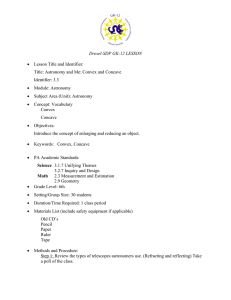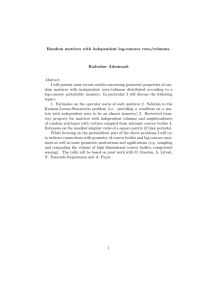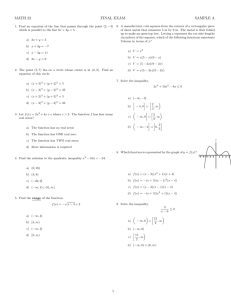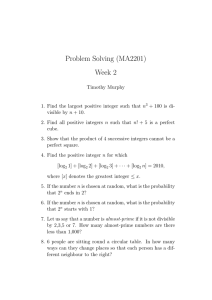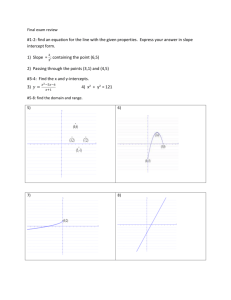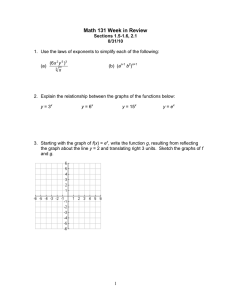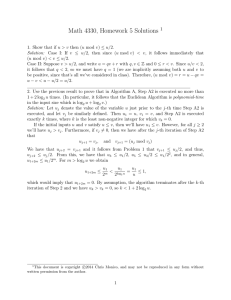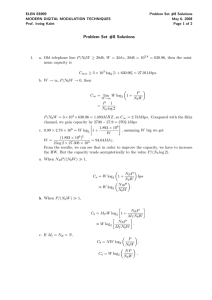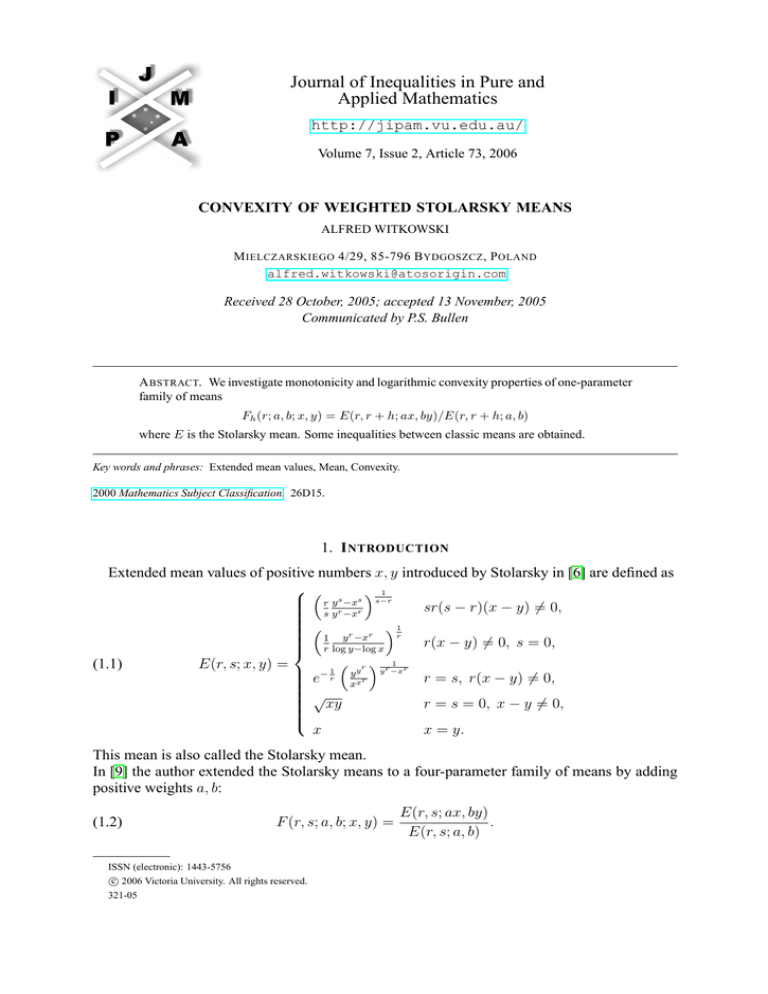
Journal of Inequalities in Pure and
Applied Mathematics
http://jipam.vu.edu.au/
Volume 7, Issue 2, Article 73, 2006
CONVEXITY OF WEIGHTED STOLARSKY MEANS
ALFRED WITKOWSKI
M IELCZARSKIEGO 4/29, 85-796 B YDGOSZCZ , P OLAND
alfred.witkowski@atosorigin.com
Received 28 October, 2005; accepted 13 November, 2005
Communicated by P.S. Bullen
A BSTRACT. We investigate monotonicity and logarithmic convexity properties of one-parameter
family of means
Fh (r; a, b; x, y) = E(r, r + h; ax, by)/E(r, r + h; a, b)
where E is the Stolarsky mean. Some inequalities between classic means are obtained.
Key words and phrases: Extended mean values, Mean, Convexity.
2000 Mathematics Subject Classification. 26D15.
1. I NTRODUCTION
Extended mean values of positive numbers x, y introduced by Stolarsky in [6] are defined as
1
r y s −xs s−r
sr(s − r)(x − y) 6= 0,
s yr −xr
r1
1 y r −xr
r(x − y) 6= 0, s = 0,
r log y−log x
1
yr yr −x
(1.1)
E(r, s; x, y) =
r
y
− r1
e
r = s, r(x − y) 6= 0,
r
x
x
√
xy
r = s = 0, x − y 6= 0,
x
x = y.
This mean is also called the Stolarsky mean.
In [9] the author extended the Stolarsky means to a four-parameter family of means by adding
positive weights a, b:
(1.2)
F (r, s; a, b; x, y) =
ISSN (electronic): 1443-5756
c 2006 Victoria University. All rights reserved.
321-05
E(r, s; ax, by)
.
E(r, s; a, b)
2
A LFRED W ITKOWSKI
From the continuity of E it follows that F is continuous in R2 × R2+ × R2+ . Our goal in this
paper is to investigate the logarithmic convexity of
(1.3)
Fh (r; a, b; x, y) = F (r, r + h; a, b; x, y).
In [1] Horst Alzer investigated the one-parameter mean
(1.4)
J(r) = J(r; x, y) = E(r, r + 1; x, y)
and proved that for x 6= y, J is strictly log-convex for r < −1/2 and strictly log-concave for
r > −1/2. He also proved that J(r)J(−r) ≤ J 2 (0). In [2] he obtained a similar result for the
Lehmer means
xr+1 + y r+1
(1.5)
L(r) = L(r; x, y) =
.
xr + y r
With an appropriate choice of parameters in (1.2) one can obtain both the one-parameter
mean and the Lehmer mean. Namely,
J(r; x, y) = F (r, r + 1; 1, 1; x, y)
and
L(r, x, y) = F (r, r + 1; x, y; x, y).
Another example may be the mean created the same way from the Heronian mean
√
√ √
xr+1 + xy r+1 + y r+1
(1.6)
N (r; x, y) = F (r, r + 1; x, y; x, y) =
.
√
xr + xy r + y r
The following monotonicity properties of weighted Stolarsky means have been established
in [9]:
Property 1.1. F increases in x and y.
Property 1.2. F increases in r and s if (x − y)(a2 x − b2 y) > 0 and decreases if (x − y)(a2 x −
b2 y) < 0.
Property 1.3. F increases in a if (x − y)(r + s) > 0 and decreases if (x − y)(r + s) < 0, F
decreases in b if (x − y)(r + s) > 0 and increases if (x − y)(r + s) < 0.
Definition 1.1. A function f : R →R is said to be symmetrically convex (concave) with respect
to the point r0 if f is convex (concave) in (r0 , ∞) and for every t > 0 f (r0 + t) + f (r0 − t) =
2f (r0 ).
Definition 1.2. A function f : R → R+ is said to be symmetrically log-convex (log-concave)
with respect to the point r0 if log f is symmetrically convex (concave) w.r.t. r0 .
For symmetrically log-convex functions the symmetry condition reads f (r0 + t)f (r0 − t) =
f 2 (r0 ). We shall recall now two properties of convex functions.
Property 1.4. If f is convex (concave) then for h > 0 the function g(t) = f (t + h) − f (t) is
increasing (decreasing). For h < 0 the monotonicity of g reverses.
For log-convex f the same holds for g(t) = f (t + h)/f (t).
Property 1.5. If f is convex (concave) then for arbitrary x the function hx (t) = f (x − t) +
f (x + t) is increasing (decreasing) in (0, ∞). For log-convex f the same holds for hx (t) =
f (x − t)f (x + t).
The property 1.5 holds also for symmetrically convex (concave) functions:
J. Inequal. Pure and Appl. Math., 7(2) Art. 73, 2006
http://jipam.vu.edu.au/
C ONVEXITY OF W EIGHTED S TOLARSKY M EANS
3
Lemma 1.6. Let f be symmetrically convex w.r.t. r0 , and let x > r0 . Then the function hx (t) =
f (x − t) + f (x + t) is increasing (decreasing) in (0, ∞). If x < r0 then hx (t) decreases.
For f symmetrically concave the monotonicity of hx is reverse.
For the case where f is symmetrically log-convex (log-concave) hx (t) = f (x + t)f (x − t) is
monotone accordingly.
Proof. We shall prove the lemma for f symmetrically convex and x > r0 . For x < r0 or f
symmetrically convex the proofs are similar.
Consider two cases:
• 0 < t < x − r0 . In this case hx (t) is increasing by Property 1.5.
• t > x − r0 . Now hx (t) = f (x + t) + f (x − t) = 2f (r0 ) + f (x + t) − f (t − x + 2r0 )
increases by Property 1.4 because t − x + 2r0 > r0 and (x + t) − (t − x + 2r0 ) > 0.
2. M AIN R ESULT
It is obvious that the monotonicity of Fh matches that of F . The main result consists of the
following theorem:
Theorem 2.1. If (x − y)(a2 x − b2 y) > 0 (resp. < 0) then Fh (r) is symmetrically log-concave
(resp. log-convex) with respect to the point −h/2).
To prove it we need the following
Lemma 2.2. Let
g(t, A, B) =
At log2 A
B t log2 B
−
.
(At − 1)2 (B t − 1)2
Then
(1) g(t, A, B) = g(±t, A±1 , B ±1 ),
(2) g is increasing in t on (0, ∞) if log2 A − log2 B > 0 and decreasing otherwise.
Proof. (1) becomes obvious when we write
log2 A
log2 B
g(t, A, B) = t
−
.
A − 2 + A−t B t − 2 + B −t
From (1) if follows that replacing A, B with A−1 , B −1 if necessary we may assume that A, B >
1. In this case sgn(log2 A − log2 B) = sgn(At − B t ).
∂g
At (At + 1) log3 A B t (B t + 1) log3 B
=−
+
∂t
(At − 1)3
(B t − 1)3
1
1
= − 3 (φ(At ) − φ(B t )) = − 3 (At − B t )φ0 (ξ),
t
t
t
t
where ξ > 1 lies between A and B and
u(u + 1) log3 u
.
(u − 1)3
To complete the proof it is enough to show that φ0 (u) < 0 for u > 1.
(u2 + 4u + 1) log2 u 3(u2 − 1)
0
φ (u) =
− log u ,
(u − 1)4
u2 + 4u + 1
φ(u) =
2
−1)
so the sign of φ0 is the same as the sign of ψ(u) = u3(u
2 +4u+1 − log u. But ψ(1) = 0 and
ψ 0 (u) = −(u − 1)4 /u(u2 + 4u + 1)2 < 0, so φ(u) < 0.
J. Inequal. Pure and Appl. Math., 7(2) Art. 73, 2006
http://jipam.vu.edu.au/
4
A LFRED W ITKOWSKI
Proof of Theorem 2.1. First of all note that
log2
ax
a
x
a2 x
− log2 = log log 2
by
b
y
by
and because sgn(x − y) = sgn log xy we see that
ax
a
− log2
sgn(x − y)(a x − b ) = sgn log
by
b
2
(2.1)
y
2
.
Let A = ax
and B = ab . Suppose that A, B 6= 1 (in other cases we use a standard continuity
by
argument). Fh (r) can be written as
r+h
1
A
− 1 Ar − 1 h
Fh (r) = y
,
B r+h − 1 B r − 1
We show symmetry by performing simple calculations:
Fhh (−h/2 − r)Fhh (−h/2 + r)
Ah/2−r − 1 B −h/2−r − 1 Ah/2+r − 1 B −h/2+r − 1
·
·
·
B h/2−r − 1 A−h/2−r − 1 B h/2+r − 1 A−h/2+r − 1
B −h Ah/2−r − 1 1 − B h/2+r Ah/2+r − 1 1 − B h/2−r
= y 2h −h · h/2−r
·
·
·
A
B
− 1 1 − Ah/2+r B h/2+r − 1 1 − Ah/2−r
h
x
2h
=y
= (xy)h = Fh2h (−h/2).
y
= y 2h
(2.2)
Differentiating twice we obtain
d2
g(r, A, B) − g(r + h, A, B)
log Fh (r) =
2
dr
h
g(|r|, A, B) − g(|r + h|, A, B)
=
h
hence by Lemma 2.2 (2)
sgn
(by Lemma 2.2 (1)),
d2
log Fh (r) = sgn h(|r| − |r + h|)(log2 A − log2 B)
dr2
= sgn(r + h/2)(x − y)(a2 x − b2 y).
The last equation follows from (2.1) and from the fact that the inequality |r| < |r + h| is valid
if and only if r > −h/2 and h > 0 or r < −h/2 and h < 0.
The following theorem is an immediate consequence of Theorem 2.1 and Lemma 1.6.
Theorem 2.3. If (x − y)(a2 x − b2 y)(r0 + h/2) > 0 then the function
Φ(t) = Fh (r0 − t)Fh (r0 + t)
is decreasing in (0, ∞). In particular for every real t
(2.3)
Fh (r0 − t)Fh (r0 + t) ≤ Fh2 (r0 ).
If (x − y)(a2 x − b2 y)(r0 + h/2) < 0 then Φ(t) is increasing in (0, ∞). In particular for every
real t
(2.4)
Fh (r0 − t)Fh (r0 + t) ≥ Fh2 (r0 ).
The following corollaries are immediate consequences of Theorems 2.1 and 2.3:
J. Inequal. Pure and Appl. Math., 7(2) Art. 73, 2006
http://jipam.vu.edu.au/
C ONVEXITY OF W EIGHTED S TOLARSKY M EANS
5
Corollary 2.4. For x 6= y the one-parameter mean J(r) defined by (1.4) is log-convex for
r < −1/2 and log-concave for r > −1/2. If r0 > −1/2 then for all real t, J(r0 − t)J(r0 + t) ≤
J 2 (r0 ). For r0 < −1/2 the inequality reverses.
Proof. J(r; x, y) = F1 (r; 1, 1; x, y).
Corollary 2.5. For x 6= y the Lehmer mean L(r) defined by (1.5) is log-convex for r < −1/2
and log-concave for r > −1/2. If r0 > −1/2 then for all real t, L(r0 − t)L(r0 + t) ≤ L2 (r0 ).
For r0 < −1/2 the inequality reverses.
Proof. L(r; x, y) = F1 (r; x, y; x, y).
Corollary 2.6. For x 6= y the mean N (r) defined by (1.6) is log-convex for r < −1/2 and
log-concave for r > −1/2. If r0 > −1/2 then for all real t, N (r0 − t)N (r0 + t) ≤ N 2 (r0 ). For
r0 < −1/2 the inequality reverses.
√ √
Proof. N (r; x, y) = F1 (r; x, y; x, y).
3. A PPLICATION
In this section we show some inequalities between classic means:
r
1
x + yr r
Power means
Ar = Ar (x, y) =
,
2
2xy
Harmonic mean
H = A−1 (x, y) =
,
x+y
√
Geometric mean
G = A0 (x, y) = xy,
x−y
Logarithmic mean
L = L(x, y) =
,
log x − log y
√
x + xy + y
Heronian mean
N = N (x, y) =
,
3
x+y
Arithmetic mean
A = A1 (x, y) =
,
2
2 x2 + xy + y 2
Centroidal mean
T = T (x, y) =
,
3
x+y
r
x2 + y 2
,
Root-mean-square
R = A2 (x, y) =
2
x2 + y 2
Contrharmonic mean
C = C(x, y) =
.
x+y
Corollary 3.1 (Tung-Po Lin inequality [4]).
L ≤ A1/3 .
Proof. By Theorem 2.3
2
F1/3 (0; 1, 1, ; x, y)F1/3 (2/3; 1, 1; x, y) ≤ F1/3
(1/3; 1, 1; x, y)
or
√
3
√ 3
x− 3y
3
log x − log y
2
x−y
p
√
3
3 x2 − 3 y 2
!3
≤
p !6
√
3
1 x2 − 3 y 2
√
.
√
2 3x− 3y
Simplifying we obtain
L3 (x, y) ≤ A31/3 (x, y).
J. Inequal. Pure and Appl. Math., 7(2) Art. 73, 2006
http://jipam.vu.edu.au/
6
A LFRED W ITKOWSKI
Inequalities in the table below can be shown the same way as above by an appropriate choice
of parameters in (2.3) and (2.4).
No
Inequality
h
r0
t
a
b
1
L2 ≥ GN
1/2
0
1
1
1
2
2
L ≥ HT
1
0
2
1
1
3
A21/2 ≥ AG
1/2
0
1/2
x
y
4
A21/2 ≥ LN
1/2
1/2
1/2
1
1
2
5
N ≥ AL
1
1/2
1/2
1
1
6
A2 ≥ LT
1
1
1
1
1
7
A2 ≥ CH
1
0
1
x
y
8
LN ≥ AG
1/2
1/2
1
1
1
9
GN ≥ HT
1
−1
1/2
x
y
10
AN ≥ T G
1/2
0
1
x
y
11
LT ≥ HC
1
1
2
1
1
12
TA ≥ NR
1
1/2
1/2
x
y
13
L3 ≥ AG2
1
0
1
1
1
14
L3 ≥ GA21/2
1/2
−1/2
1/2
1
1
3
2
15
N ≥ AA1/2
1/2
1
1/2
1
1
3
2
16
T ≥ AR
1
2
1
1
1
17
LN 2 ≥ G2 T
1
1/2
3/2
1
1
Note that 4 is stronger than 3 (due to inequality 8), 14 is stronger than 13 (due to 3). Also, 1
is stronger than 2 because of 9.
R EFERENCES
[1] H. ALZER, Über eine einparametrige Familie von Mittelwerten, Bayer. Akad. Wiss. Math.-Natur.
Kl. Sitzungsber, 1987 (1988), 1–9.
[2] H. ALZER, Über Lehmers Mittelwertefamilie, Elem. Math., 43 (1988), 50–54.
[3] E. LEACH AND M. SHOLANDER, Extended mean values, Amer. Math. Monthly, 85 (1978), 84–90.
[4] T.-P. LIN, The power mean and the logarithmic mean, Amer. Math. Monthly, 81(8) (1974), 879–883.
[5] E. NEUMAN AND Zs. PÁLES, On comparison of Stolarsky and Gini means, J. Math. Anal. Appl.,
278 (2003), 274–285.
[6] K.B. STOLARSKY, Generalizations of the logarithmic mean, Math. Mag., 48 (1975), 87–92.
[7] FENG QI, Generalized weighted mean values with two parameters, Proc. Roy. Soc. London
Ser. A, 454 (1998), No. 1978, 2723–2732.
[8] A. WITKOWSKI, Monotonicity of generalized extended mean values, Colloq. Math., 99(2) (2004),
203–206. RGMIA Research Report Collection, 7(1) (2004), Art. 12. [ONLINE: http:/rgmia.
vu.edu.au/v7n1.html].
[9] A. WITKOWSKI, Weighted extended mean values, Colloq. Math., 100(1) (2004), 111–117. RGMIA
Research Report Collection, 7(1) (2004), Art. 6. [ONLINE: http:/rgmia.vu.edu.au/v7n1.
html].
J. Inequal. Pure and Appl. Math., 7(2) Art. 73, 2006
http://jipam.vu.edu.au/


